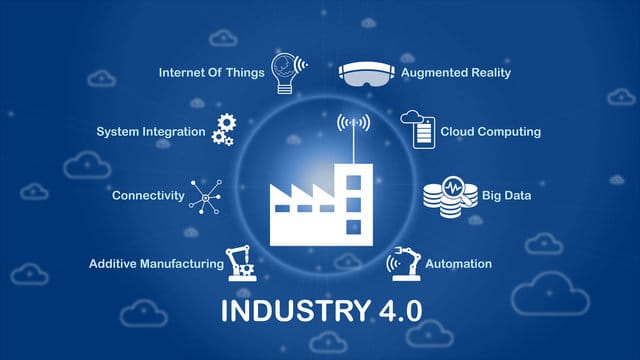The manufacturing industry is rapidly transforming by adopting advanced technologies such as artificial intelligence, machine learning, and the Internet of Things (IoT). This digital transformation has significantly improved product quality and reduced downtime for processes and machines. Industrial IoT and automation are playing a vital role in this transformation.
The global market for Industry 4.0 is expected to reach $189.5 billion by 2025. Over 60% of manufacturing companies in the United States are investing in Industry 4.0 technologies. Worldwide Industry 4.0 is expected to create over 20 million new jobs by 2025.
IIoT is disrupting industrial applications with its unique capabilities. It can significantly improve operational efficiency and workflows in factories by providing real-time monitoring of assets and processes. IIoT also offers many opportunities for manufacturers to make their operations even better.
The opportunities that IoT offers to the manufacturing industry include:
1. Automation in factories:
IoT can be used to automate tasks and processes in factories, which can lead to improved efficiency and productivity. For example, IoT-enabled robots can be used to perform repetitive tasks, freeing up human workers to focus on more complex tasks.
2. Process optimization:
IoT can be used to collect data on manufacturing processes and identify areas where improvements can be made. This data can be used to optimize things like the flow of materials, the use of energy, and the quality of products.
3.Intelligent manufacturing:
IoT can be used to create smart factories that are able to make decisions and take actions on their own. For example, a smart factory could use IoT data to identify a potential problem with a machine and automatically take steps to prevent it from failing.
4. Performance monitoring:
IoT can be used to monitor the performance of machines and equipment in real-time. This data can be used to identify problems early on and take corrective action before they cause major disruptions.
Industrial revolution
Overview of the Industrial Revolution, divided into its four stages:
- First Industrial Revolution (1760-1840): This was the period when steam power was first used in factories and transportation. Other key inventions of this period include the cotton gin, the power loom, and the steam locomotive. The First Industrial Revolution led to a dramatic increase in productivity and a shift from rural to urban living.
- Second Industrial Revolution (1870-1914): This period was characterized by the development of new technologies such as electricity, the internal combustion engine, and the assembly line. These technologies led to even greater increases in productivity and the rise of new industries such as automobiles and chemicals.
- Third Industrial Revolution (1950-2000): This period was marked by the development of new technologies such as computers, robotics, and automation. These technologies led to the automation of many manufacturing processes and the rise of new industries such as information technology and biotechnology.
- Fourth Industrial Revolution (2000-present): This period is still ongoing and is characterized by the development of new technologies such as artificial intelligence, big data, and the Internet of Things. These technologies are leading to a new era of automation and connectivity, which is having a profound impact on all aspects of our lives.
The main stages of IoT and Industry 4.0 evolution are:
1. Getting things connected:
This is the first stage, where physical objects are connected to the internet and sensors are used to collect data.
2. Generating insights:
In this stage, the data collected from sensors is analyzed to generate insights that can be used to improve operations.
3. Optimizing operations and processes:
This stage involves using the insights generated from the data to optimize operations and processes. This can lead to improved efficiency, productivity, and safety.
4. Innovation:
This is the final stage, where new technologies are developed to further improve the efficiency and productivity of industrial operations.
Challenges faced in Industry 4.0
1. Security and privacy:
IoT devices and systems are often vulnerable to cyberattacks, which can lead to data breaches, disruption of operations, and even physical harm. It is essential to implement robust security measures to protect IoT systems and data.
2. Integration with existing systems:
Many industrial organizations have legacy systems that are not compatible with modern IoT technologies. This can make it difficult to integrate IoT devices and systems into existing operations.
3. Cost of implementation and maintenance:
The cost of implementing and maintaining IoT systems can be significant, especially for large organizations. It is important to carefully consider the costs and benefits before implementing IoT solutions.
4. Skills shortage:
There is a shortage of skilled workers with the expertise to implement and manage IoT systems. This can make it difficult for organizations to find the right people to support their IoT initiatives.
5. Scalability and reliability challenges:
IoT systems can be complex and difficult to scale as the number of devices and connections increases. It is important to design and implement IoT systems that are scalable and reliable.
6. Data management challenges:
IoT systems generate large volumes of data that need to be stored, processed, and analyzed. This can be a challenge for organizations that do not have the necessary data management infrastructure and expertise.
7. Ethical and legal concerns:
There are a number of ethical and legal concerns associated with the use of IoT technology, such as data privacy, security, and liability. It is important to be aware of these concerns and to take steps to mitigate them.
Benefits of using IoT in industries
1. Increased efficiency and productivity:
IoT can help businesses to automate tasks, streamline workflows, and improve overall efficiency. For example, IoT sensors can be used to monitor machine performance and identify potential problems before they cause downtime. This can help businesses to reduce costs and improve productivity.
2. Improved quality control:
IoT can also help businesses to improve quality control by providing real-time data on product quality. For example, IoT sensors can be used to track product temperature, humidity, and other factors throughout the manufacturing process. This data can be used to identify and correct problems early on, preventing defective products from reaching the market.
3. Reduced costs:
IoT can help businesses to reduce costs in a number of ways. For example, IoT-enabled predictive maintenance can help businesses to reduce downtime and repair costs. Additionally, IoT can help businesses to optimize their energy consumption and reduce their environmental impact.
4. Enhanced safety:
IoT can also help businesses to enhance safety by providing real-time data on potential hazards. For example, IoT sensors can be used to monitor air quality, temperature, and vibration levels in industrial settings. This data can be used to identify and address potential hazards before they cause accidents.
5. New business opportunities:
IoT can also help businesses to create new products and services. For example, IoT-enabled smart products can collect data on customer usage patterns and preferences. This data can be used to develop new products and services that better meet the needs of customers.






